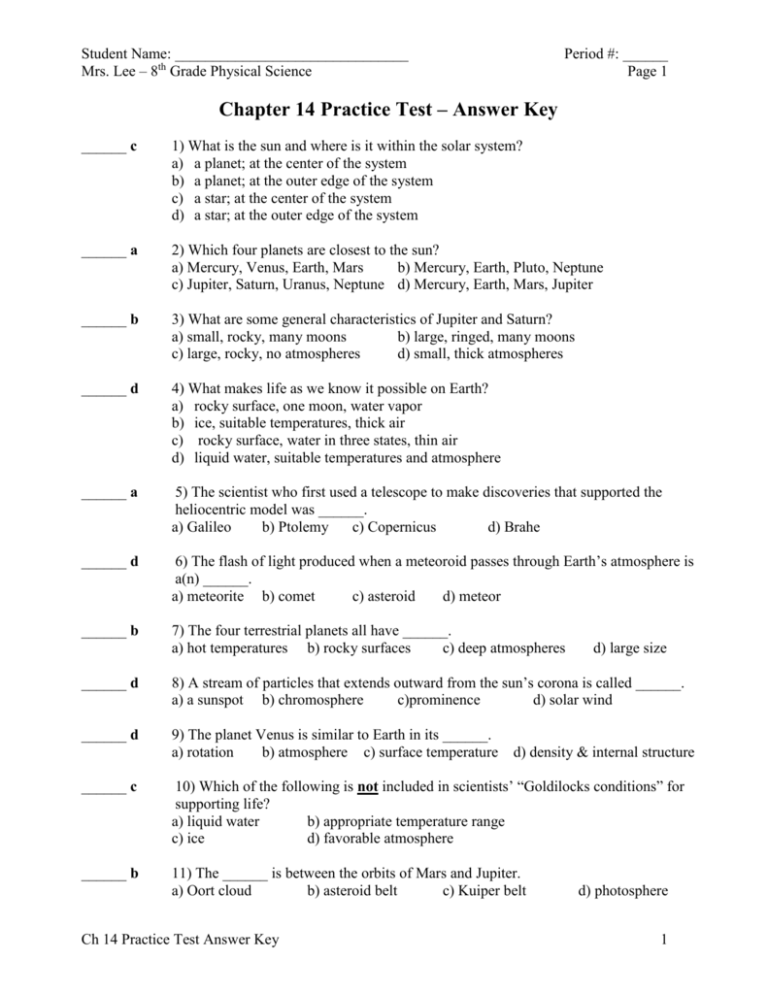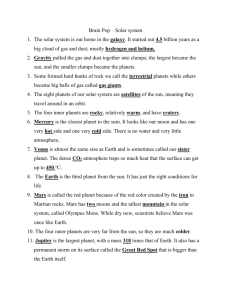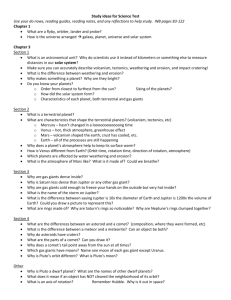Answer
advertisement

Student Name: _______________________________ Mrs. Lee – 8th Grade Physical Science Period #: ______ Page 1 Chapter 14 Practice Test – Answer Key ______ c 1) What is the sun and where is it within the solar system? a) a planet; at the center of the system b) a planet; at the outer edge of the system c) a star; at the center of the system d) a star; at the outer edge of the system ______ a 2) Which four planets are closest to the sun? a) Mercury, Venus, Earth, Mars b) Mercury, Earth, Pluto, Neptune c) Jupiter, Saturn, Uranus, Neptune d) Mercury, Earth, Mars, Jupiter ______ b 3) What are some general characteristics of Jupiter and Saturn? a) small, rocky, many moons b) large, ringed, many moons c) large, rocky, no atmospheres d) small, thick atmospheres ______ d 4) What makes life as we know it possible on Earth? a) rocky surface, one moon, water vapor b) ice, suitable temperatures, thick air c) rocky surface, water in three states, thin air d) liquid water, suitable temperatures and atmosphere ______ a 5) The scientist who first used a telescope to make discoveries that supported the heliocentric model was ______. a) Galileo b) Ptolemy c) Copernicus d) Brahe ______ d 6) The flash of light produced when a meteoroid passes through Earth’s atmosphere is a(n) ______. a) meteorite b) comet c) asteroid d) meteor ______ b 7) The four terrestrial planets all have ______. a) hot temperatures b) rocky surfaces c) deep atmospheres d) large size ______ d 8) A stream of particles that extends outward from the sun’s corona is called ______. a) a sunspot b) chromosphere c)prominence d) solar wind ______ d 9) The planet Venus is similar to Earth in its ______. a) rotation b) atmosphere c) surface temperature d) density & internal structure ______ c 10) Which of the following is not included in scientists’ “Goldilocks conditions” for supporting life? a) liquid water b) appropriate temperature range c) ice d) favorable atmosphere ______ b 11) The ______ is between the orbits of Mars and Jupiter. a) Oort cloud b) asteroid belt c) Kuiper belt Ch 14 Practice Test Answer Key d) photosphere 1 Student Name: _______________________________ Mrs. Lee – 8th Grade Physical Science Period #: ______ Page 2 Chapter 14 Practice Test – Answer Key ______ d 12) A(n) ______ is a loose collection of ice, dust, and small rocky particles that typically has a long, narrow orbit. a) asteroid b) planet c) meteoroid d) comet ______ a 13) ______ are loops of gas on the sun that link different parts of sunspot regions together. a) Prominences b) Solar Flares c) Solar winds d) Auroras ______ b (convection) 14) In the sun’s radiation zone, hot gases rise and move energy toward the sun’s surface. a) True b) False ______ b (heliocentric) a) True 15) A geocentric model of the planets is sun-centered. b) False ______ a 16) Solar flares are eruptions that occur when gas on the surface of the sun becomes extremely hot. a) True b) False ______ a 17) Asteroids are rocky objects in orbit that are too small and too numerous to be considered planets. a) True b) False ______ b (fusion) 18) The sun’s energy comes from nuclear fission. a) True b) False ______ c 19) What are loops of gas on the sun that link different parts of sunspot regions together? a) solar flares b) solar winds c) prominences ______ b 20) What process provides the sun with energy? a) solar winds b) nuclear fusion c) greenhouse effect ______ c 21) The “red planet” is ______. a) Venus b) Uranus c) Mars. ______ a 22) Which planet is the smallest terrestrial planet? a) Mercury b) Earth c) Pluto ______ b 23) The planet with the most spectacular rings of any planet is ______. a) Neptune b) Saturn c) Jupiter ______ c 24) A loose collection of ice, dust, and small rocky particles that orbits the sun is a(n) ______. a) asteroid b) meteoroid c) comet Ch 14 Practice Test Answer Key 2 Student Name: _______________________________ Mrs. Lee – 8th Grade Physical Science Period #: ______ Page 3 Chapter 14 Practice Test – Answer Key ______ a 25) A flash of light in the night sky is a(n) ______. a) meteor b) asteroid c) meteorite ______ a 26) An ellipse is an oval shape. a) True b) False ______ a 27) Areas of gas on the sun that are cooler than the gases around them are called sunspots. a) True b) False ______ b (terrestrial) a) True 28) The inner planets are often called the ring planets. b) False ______ b (ring) 29) A thin disk of small particles of ice and rock around a planet is a meteor. a) True b) False ______ a 30) A meteoroid that passes through the atmosphere and hits Earth’s surface is a meteorite. a) True b) False ______ a 31) A heliocentric model of the solar system is sun-centered. a) True b) False ______ b 32) When you look at an image of the sun, you are looking at the chromosphere. a) True b) False ______ a 33) The first four outer planets are often called gas giants. a) True b) False ______ b 34) A comet is a rocky object in the solar system that is too small to be a planet. a) True b) False ______ a 35) Life other than that on Earth would be called extraterrestrial life. a) True b) False The picture shows a star and 3 planets that are orbiting the star. Use the picture to answer the following 3 questions: Ch 14 Practice Test Answer Key 3 Student Name: _______________________________ Mrs. Lee – 8th Grade Physical Science Period #: ______ Page 4 Chapter 14 Practice Test – Answer Key ______ a 36) Interpreting Diagrams: Which planet is closest to the star? a) Planet A b) Planet B c) Planet C ______ c 37) Inferring: Which planet will take the longest time to revolve around the star? a) Planet A b) Planet B c) Planet C ______ c 38) Applying Concepts: Suppose the star is our sun and Planet B is Earth. In a heliocentric system, which would be true? a) Planet B would revolve around Planet C b) The star would revolve around Planet B c) Planet B would revolve around the star The table below shows 3 characteristics of Jupiter’s 4 largest moons. Use the table to answer the following 2 questions: Jupiter’s Largest Moons Moon Diameter (km) Average Distance from Jupiter (km) Io Europa Ganymede Callisto 3,642 3,120 5,268 4,800 421,600 670,900 1,070,000 1,883,000 Length of Revolution Around Jupiter (Earth days) 1.8 3.5 7.2 16.7 ______ b 39) Interpreting Tables: Which of the four large moons of Jupiter is the largest? a) Europa b) Ganymede c) Callisto ______ c 40) Inferring: Why does Callisto take the longest to revolve around Jupiter? a) Callisto has the greatest diameter of the four moons b) Callisto is the closest of the four moons to Jupiter c) Callisto is the farthest of the four moons away from Jupiter Ch 14 Practice Test Answer Key 4








